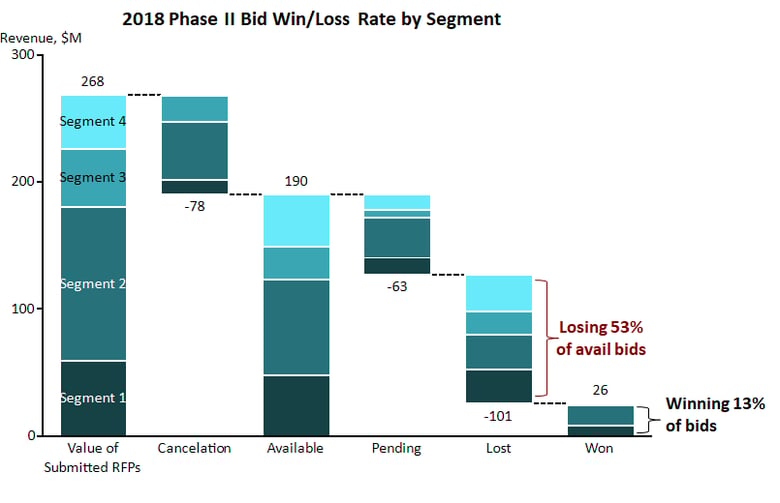The decrease in early phase clinical trial win rates put revenue and profitability at risk and threatened the company’s longer-term growth as trial sponsors build experience and relationships with a CRO during early phase trials and often look to continue the relationship into later phase trials—which are more extensive and profitable.
The CRO lacked actionable competitive information to substantiate strategy for opportunities and was unable to easily compare bids and project plans from one proposal to another. Adding to the challenge, the company approached proposal development with a bottoms-up approach, which led each functional area to independently—and in isolation—create its portion of the overall proposal.
This approach often led to duplication of proposed activities and resources as well as the incorporation of services not specifically requested by sponsors. Our client needed to reliably benchmark and compare proposals before final submission, and needed to move towards a top-down proposal process where the functional areas worked in partnership to develop an appropriately scoped proposal at a competitive and profitable price.

With a strong understanding of clinical research organizations and the pharmaceutical industry, WP&C quickly evaluated the current state of our client’s proposal and bidding process. Our approach to improving the competitiveness of its proposals centered on three key areas:
- Build Tools to Quickly Find Reality: Rather than relying only on anecdotal feedback from trial sponsors and conflicting viewpoints from within the organization, WP&C developed a set of benchmarking tools that aggregated information from thousands of previous proposals to quickly understand, in detail, the differences between winning and losing proposals—including metrics focused on project financial performance, scoping, and overall resource requirements.
- Challenge Assumptions and Align on Solutions: With actionable information from the benchmarking tools, WP&C was able to challenge the client’s deeply-held assumptions that often led to bloated proposals that not only failed to be priced competitively but also often failed to meet the sponsor’s expectations for how the trial would be conducted. Although the CRO had never viewed its business from these perspectives, it quickly understood the gaps in its existing proposal development strategy and process, and the functional area leaders across the entire organization quickly aligned on a plan to implement the new tools and new strategy.
- Leverage Momentum and Deliver Quickly: Using the newly available information and organizational alignment, WP&C was able to work with the CRO to evaluate a limited set of active proposals under development. Senior business development executives participated in the proposal evaluations and were able to quickly identify high-level pricing concerns that revealed incorrectly scoped projects and uncompetitive pricing before the final bids were submitted.
.png?width=780&name=Sample%20Dashboard%20(1).png)
After our evaluation of the CRO’s proposal and pricing process, WP&C recommended the client use the newly developed tool to pull together existing but dis-aggregated information from past proposals and the enterprise-wide customer relationship management tool to provided actionable information for future proposals.
Additionally, WP&C recommended a shift from the bottom-up to a top-down pricing model that required collaboration between functional area leaders across the business to develop competitive project bids. Lastly, we recommended and developed training and users’ guides to accompany the rollout and integration of the Benchmarking Tool into the proposal development process.
New business development and capture is core to every company’s strategy. In a period of only a few weeks, WP&C assisted senior client executives in developing and successfully implementing a new proposal and pricing strategy, and significantly shifted the thinking of business leaders across functional areas.
- Unlocking New Understanding about Each Proposal: The new Benchmarking Tool provides deep insight into how business leaders approach projects in different parts of the business. Analyzing the characteristics of thousands of wins and losses and providing pricing guardrails, senior executives are now equipped with a quick and effective way to evaluate the competitiveness of outgoing proposals and a new tool for analyzing marketplace trends. Additionally, the deep insights created by the tool have resulted in a company-wide discussion amongst business leaders about how resources are allocated and managed.
- Reducing Complexity in the Proposal Process: With new tools and a top-down proposal creation process, business leaders can quickly evaluate and rank opportunities—thereby focusing resources on the highest-value, most-likely-to-win opportunities.


.png?width=780&name=Sample%20Dashboard%20(1).png)